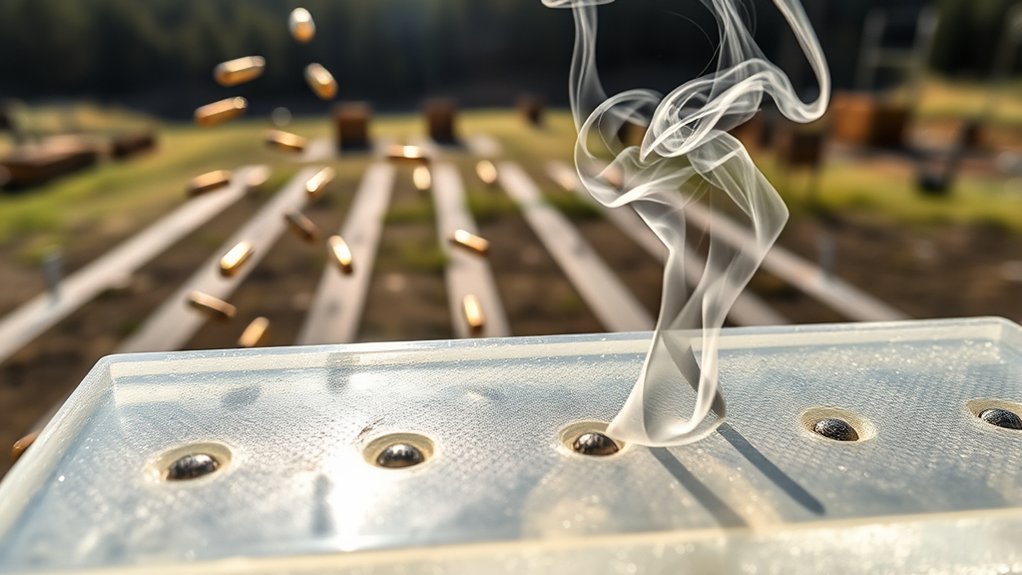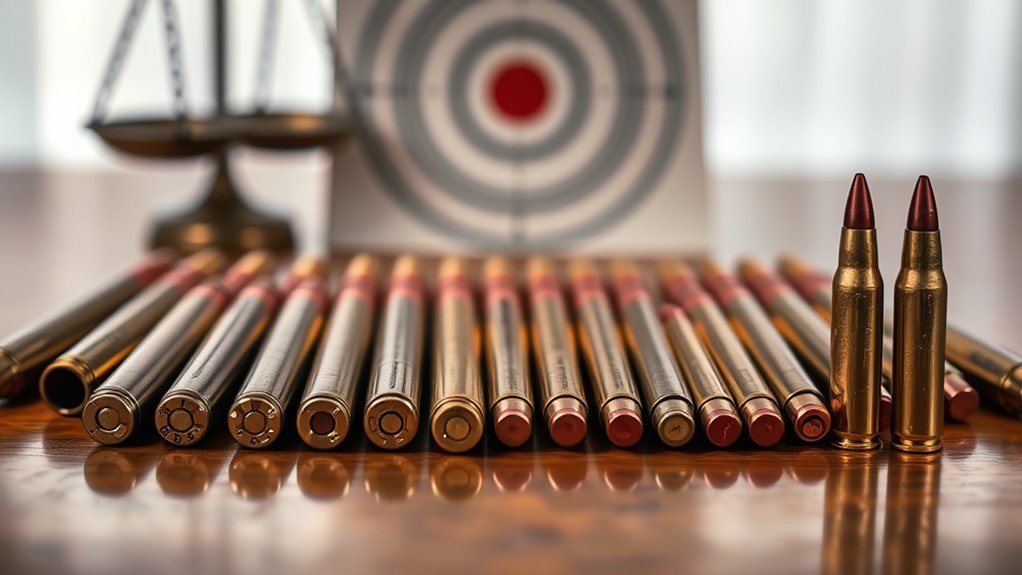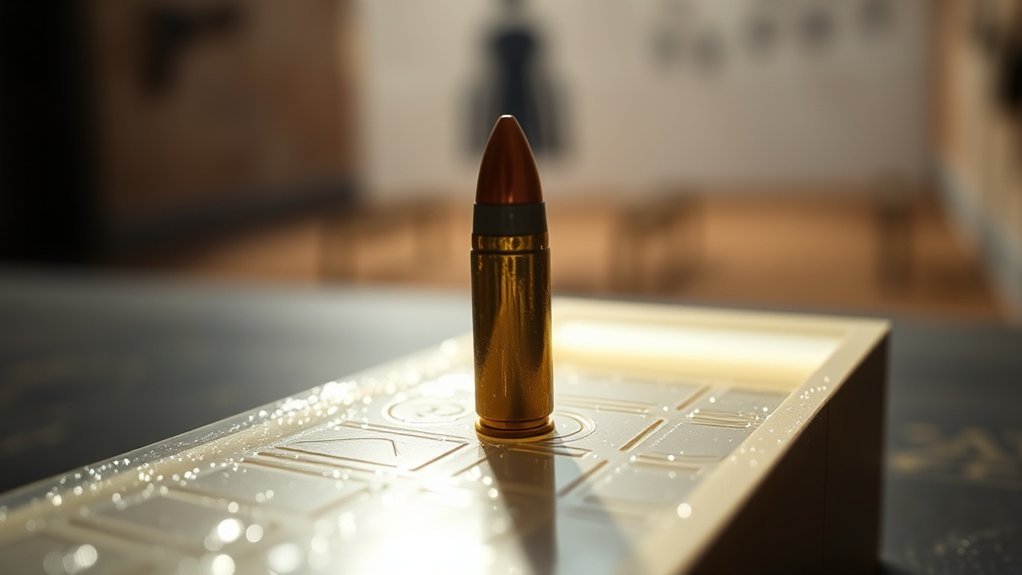Terminal ballistics involves intricate principles that govern how projectiles behave on impact, influencing factors such as penetration and tissue damage. Most people overlook the ethical implications tied to ammunition design and usage. Understanding these dynamics is essential not just for military and law enforcement applications, but also for civilian contexts. As you explore these facets, consider how knowledge of terminal effects can shape responsible firearm ownership and use in today’s complex landscape.
Understanding Terminal Ballistics

When you consider the impact of a projectile upon striking a target, you’re delving into the domain of terminal ballistics. This field examines the behavior and effects of projectiles upon impact, focusing on energy transfer, penetration, and tissue damage. Terminal ballistics involves analyzing factors such as bullet design, velocity, and material properties of both the projectile and target. You need to understand how these variables interact to predict the projectile’s performance and effects. For instance, a hollow-point bullet expands upon impact, maximizing energy transfer and causing greater tissue disruption. Conversely, a full metal jacket may penetrate deeper but cause less immediate damage. By grasping these principles, you can assess the effectiveness of various ammunition types in real-world scenarios.
The Physics of Projectiles

Understanding the physics behind projectiles involves analyzing kinetic energy transfer and the dynamics of impact. You’ll see how energy is transferred upon impact, influencing the effectiveness of a projectile. By grasping these concepts, you can better appreciate the mechanics at play in terminal ballistics.
Kinetic Energy Transfer
Kinetic energy transfer in projectiles is a critical factor that influences their effectiveness upon impact. When a projectile strikes a target, it transfers its kinetic energy, determined by its mass and velocity, to that target. The efficiency of this transfer depends on several factors, including the projectile’s design, material properties, and impact angle. A higher velocity typically results in greater kinetic energy, enabling more effective penetration and deformation upon impact. Additionally, the projectile’s shape can influence how energy is distributed within the target, affecting damage patterns. Understanding these dynamics allows you to evaluate various projectiles for specific applications, ensuring ideal performance while considering ethical implications in their use. Consequently, proper analysis of kinetic energy transfer is essential for responsible ballistics.
Impact Dynamics Explained
The interaction between a projectile and its target is governed by complex physics principles that dictate impact dynamics. When a projectile strikes, the kinetic energy is transferred, resulting in deformation and momentum exchange. This transfer depends on factors like velocity, mass, and material properties. You’ll notice that higher velocities generally increase penetration depth due to greater energy concentration at the impact point. Additionally, the angle of impact markedly affects the outcome; oblique angles can result in ricochet or glancing blows, reducing effectiveness. Understanding these dynamics enables you to predict the behavior of projectiles upon impact, informing design choices in ammunition and protective equipment. Ultimately, this knowledge enhances both the efficacy and ethical implications of projectile use in various applications.
Types of Ammunition and Their Impact

When selecting ammunition, understanding bullet design variations is essential for predicting performance and impact. Different calibers considerably affect penetration and energy transfer upon impact, influencing terminal effects. You’ll need to evaluate these factors to effectively assess the ammunition’s suitability for specific applications.
Bullet Design Variations
While various bullet design variations exist, each type of ammunition significantly influences terminal performance and effectiveness in different scenarios. Full metal jacket (FMJ) rounds, for instance, penetrate deeply but often fail to expand, making them less effective in stopping power. In contrast, hollow-point bullets expand upon impact, creating larger wound channels and transferring energy efficiently to the target. Soft-point ammunition also offers expansion but with a balance of penetration, suitable for hunting applications. Additionally, frangible bullets disintegrate upon impact, minimizing over-penetration risks, ideal for close-quarters scenarios. Each design variation serves specific purposes, affecting factors like accuracy, recoil, and environmental considerations. Understanding these differences allows you to select the right ammunition for your intended use, enhancing safety and effectiveness.
Caliber and Penetration Effects
Understanding caliber and its effects on penetration is essential for selecting the right ammunition for specific situations. Caliber refers to the diameter of the bullet and greatly influences its terminal performance. Larger calibers typically create wider wound channels and can offer deeper penetration, especially when using full metal jacket (FMJ) rounds. Conversely, smaller calibers may produce less penetration but can excel in expanding types, like hollow points, which maximize tissue damage upon impact. Additionally, the type of material the bullet is designed to penetrate—such as soft tissue versus hard barriers—affects overall performance. Always consider the target and environment when selecting ammunition, as different calibers serve distinct purposes, ensuring ideal effectiveness and ethical considerations in terminal ballistics.
Energy Transfer and Tissue Damage
Energy transfer during a ballistic event greatly impacts tissue damage, as the kinetic energy of a projectile converts into mechanical forces upon impact. When a bullet strikes, its energy creates a shockwave, causing immediate cellular disruption and necrosis. This energy transfer is not uniform; it varies based on factors like velocity, mass, and material properties of both the projectile and the tissue. High-velocity projectiles often result in extensive cavitation, leading to secondary injuries beyond the direct path of penetration. Understanding these dynamics is essential for evaluating the potential for incapacitation and lethality in a given scenario. As you analyze energy transfer, consider how different projectiles interact with biological tissues to predict their effects accurately.
The Role of Caliber in Terminal Ballistics
Caliber plays an essential role in terminal ballistics, influencing both the effectiveness of a projectile and the nature of its impact on biological tissues. A larger caliber generally increases the diameter of the wound channel, leading to more significant tissue disruption. This effect is important when considering penetration and energy transfer; larger projectiles often retain energy better, enhancing their incapacitation potential. However, caliber must be balanced with factors like velocity and bullet design, as these elements also dictate terminal performance. For instance, a smaller caliber with high velocity can create devastating hydrostatic shock. Ultimately, understanding the role of caliber enables you to make informed decisions regarding ammunition selection for specific scenarios, ensuring ideal outcomes regarding effectiveness and ethical considerations.
Applications in Military and Law Enforcement
While various factors influence terminal ballistics, their applications in military and law enforcement are particularly critical, as they directly impact operational effectiveness and personnel safety. Understanding how projectiles behave upon impact helps you make informed decisions about ammunition selection and tactical approaches. Key considerations include:
- Wound ballistics: Evaluating potential injury severity and outcomes.
- Ammunition selection: Choosing the right caliber and type for specific missions.
- Range assessment: Evaluating distance effects on impact dynamics.
- Threat evaluation: Analyzing potential adversary capabilities and vulnerabilities.
- Environmental factors: Considering elements like wind and barriers that affect projectile performance.
Civilian Uses and Considerations
Understanding terminal ballistics isn’t limited to military and law enforcement applications; it also has significant implications for civilian uses, particularly in self-defense and recreational shooting. In self-defense scenarios, knowing how different ammunition types perform on impact can influence your choice. For instance, hollow-point rounds expand upon impact, maximizing energy transfer and minimizing the risk of over-penetration. This is essential for safeguarding bystanders. In recreational shooting, terminal ballistics informs decisions about projectile selection based on accuracy, trajectory, and terminal effects on targets. Understanding these variables enhances your shooting experience and guarantees safety. Additionally, awareness of ballistics fosters responsible firearm ownership, guiding you in selecting appropriate ammunition for various situations, whether for sport or protection.
Ethical Implications of Terminal Ballistics
As you explore the ethical implications of terminal ballistics, consider how the design and use of ammunition can greatly impact both human lives and broader societal norms. The decisions surrounding ammunition types and their intended applications raise significant ethical questions.
- The potential for unnecessary harm to civilians
- The responsibility of manufacturers in weapon design
- The psychological effects on users and victims
- The implications of military versus civilian ammunition use
- The impact on law enforcement and public safety
Each of these factors contributes to the moral landscape of terminal ballistics, emphasizing the need for conscientious decision-making. Understanding these implications helps in shaping a more ethical approach to ammunition and its applications, ultimately fostering a safer society.
Advocating for Responsible Usage
The ethical implications of terminal ballistics underscore the need for advocating for responsible usage of ammunition. You must recognize that each type of ammunition has specific purposes and consequences. Understanding the terminal effects on both target and environment is essential. Educate yourself on the legal regulations surrounding ammunition use in your area; compliance guarantees safety and ethical responsibility. Additionally, consider the potential impact on the ecosystem and wildlife when selecting ammunition types. Advocating for well-informed choices among peers fosters a culture of responsibility. When you engage in discussions about terminal ballistics, emphasize the importance of training and proficiency in handling firearms. Ultimately, promoting responsible usage not only protects individuals but also preserves the integrity of communities and natural habitats.
Conclusion
In understanding terminal ballistics, you grasp not just the mechanics of projectiles but the weight of their consequences. Each choice in ammunition carries a responsibility; it’s about striking a balance between effectiveness and ethical considerations. As you navigate the complexities of firearm usage, remember that knowledge empowers you to make decisions that respect both safety and humanity. Ultimately, promoting responsible practices guarantees that the impact of your actions aligns with a commitment to preserving life and minimizing harm.

